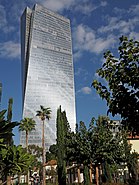Kuye: Difference between revisions
No edit summary |
|||
| Line 48: | Line 48: | ||
==History== | ==History== | ||
==Geography== | ==Geography== | ||
[[File:Abu Dhabi. 27 January 2019. European Space Agency. Copernicus. Sentinel-2.jpg|thumb|Kuye seen from [[Coalition Space Station]], 2019]] | |||
Kuye is located on the northeastern coast of Emmiria along the [[Toyana Ocean]]. It is on an island less than 250 metres (820 ft) from the mainland and is joined to the mainland by the [[Amiri Bridge|Amiri]] and [[Zuhair Bridge|Zuhair]] Bridges. Kuye lies on land that used to be sand dunes and as such has relatively poor soil fertility. The land has been largely flattened and has no important gradients; its most notable geographical features are bluffs above the Toyana coastline and the [[Jiyaan River]] mouth. | |||
Kuye has a Köppen climate classification Csa and enjoys plenty of sunshine throughout the year. Most precipitation falls in the form of rain between the months of May and September, with intervening dry summers. The average annual temperature is 20.9 °C (69.6 °F), and the average sea temperature is 18–20 °C (64–68 °F) during the winter, and 24–29 °C (75–84 °F) during the summer. The city averages 528 millimeters (20.8 in) of precipitation annually. | |||
Summers in Kuye last about seven months, from October to June. February, the warmest month, averages a high of 30.6 °C (87.1 °F), and a low of 25 °C (77 °F). The high relative humidity due to the location of the city by the Toyana Sea, in a combination with the high temperatures, creates a thermal discomfort during the summer. Summer low temperatures in Kuye seldom drop below 20 °C (68 °F). | |||
Winters are mild and wet, with most of the annual precipitation falling within the months of July, August and September as intense rainfall and thunderstorms. In July, the coolest month, the average maximum temperature is 17.6 °C (63.7 °F), the minimum temperature averages 10.2 °C (50.4 °F). During the coldest days of winter, temperatures may vary between 8 °C (46 °F) and 12 °C (54 °F). Both freezing temperatures and snowfall are extremely rare in the city. | |||
Gulf waters of Kuye holds the world's largest population of [[wikipedia:Sulifa humpback dolphins|Indo-Pacific humpbacked dolphin]]s. | |||
==Demographics== | ==Demographics== | ||
==Culture== | ==Culture== | ||
Revision as of 19:51, 17 June 2021
Kuye
| |
|---|---|
City | |
From upper left: North Kuye skyline, Subhi Sarona Tower, Maronite Cathedral of Saint George (left) and Mohammad Al-Masa Mosque (right), Kuye Promenade, South Kuye skyline | |
| Country | Emmiria |
| Province | Kuye |
| Government | |
| • Mayor | Nawaar el-Noorani |
| Area | |
| • Total | 972 km2 (375 sq mi) |
| Elevation | 5 m (16 ft) |
| Population | |
| • Total | 6,337,303 |
Kuye is a port city in Emmiria. It is located in the northeast corner of the nation on the shore of the North Toyana Ocean. It has a population of over 6.3 million, making it the third largest city in Emmiria after Rhaga and Hazarabad. It is also one of the largest cities on the continent of Adula and one of the largest cities in the world. It is home to many international embassies, companies, and conferences that attract a lot of diplomacy and business. A "party capital" in the generally reserved culture of the Islamic world and East Adula, it has a lively nightlife and 24-hour culture. Kuye University is the nation's second largest university and one of the largest in the world by enrollment with over 100,000 students.
History
Geography

Kuye is located on the northeastern coast of Emmiria along the Toyana Ocean. It is on an island less than 250 metres (820 ft) from the mainland and is joined to the mainland by the Amiri and Zuhair Bridges. Kuye lies on land that used to be sand dunes and as such has relatively poor soil fertility. The land has been largely flattened and has no important gradients; its most notable geographical features are bluffs above the Toyana coastline and the Jiyaan River mouth.
Kuye has a Köppen climate classification Csa and enjoys plenty of sunshine throughout the year. Most precipitation falls in the form of rain between the months of May and September, with intervening dry summers. The average annual temperature is 20.9 °C (69.6 °F), and the average sea temperature is 18–20 °C (64–68 °F) during the winter, and 24–29 °C (75–84 °F) during the summer. The city averages 528 millimeters (20.8 in) of precipitation annually.
Summers in Kuye last about seven months, from October to June. February, the warmest month, averages a high of 30.6 °C (87.1 °F), and a low of 25 °C (77 °F). The high relative humidity due to the location of the city by the Toyana Sea, in a combination with the high temperatures, creates a thermal discomfort during the summer. Summer low temperatures in Kuye seldom drop below 20 °C (68 °F).
Winters are mild and wet, with most of the annual precipitation falling within the months of July, August and September as intense rainfall and thunderstorms. In July, the coolest month, the average maximum temperature is 17.6 °C (63.7 °F), the minimum temperature averages 10.2 °C (50.4 °F). During the coldest days of winter, temperatures may vary between 8 °C (46 °F) and 12 °C (54 °F). Both freezing temperatures and snowfall are extremely rare in the city.
Gulf waters of Kuye holds the world's largest population of Indo-Pacific humpbacked dolphins.




